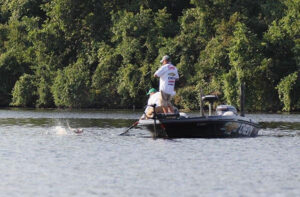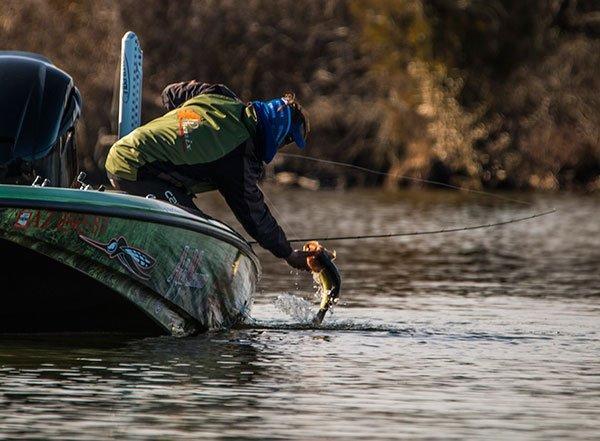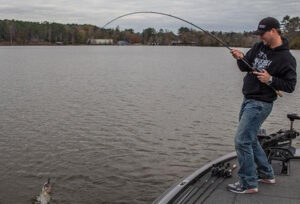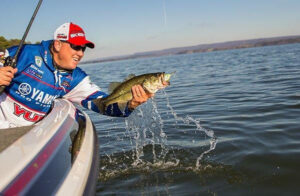Some anglers say finding and patterning bass is the toughest facet of our sport. Others, however, believe tricking them into biting is most difficult. While they’re both inherently challenging, we must not forget the importance of landing bass. After all, an inability to effectively land big bass kind of makes finding and catching them a moot point, right?
Everyone reading this article could write books about the ones that got away. It’s a common cliché in bass fishing, but it’s true nonetheless. Much of our hard work and research flies out the window when a giant bass slips through our fingertips. It’s a gut-wrenching feeling that we all take steps to avoid.
There are three effective ways to land bass, however, and learning the advantages and disadvantages of both will drastically increase your landing ratio and decision making. These aren’t the only ways to do it, but we’ve had our best success with these methods.
- Use a net
- Swing them into the boat
- Belly land them
https://s3media.247sports.com/Uploads/wired2fish/2014/03/bryan-thrift-netting-jumping-bass.jpg

Biggun! Get the net!
It’s a phrase we wait all workweek to shout on Saturday mornings and, not surprisingly, it’s indicative of the most popular way of landing bass—with a long-handled net. Whether you fish from the bank or a boat, there’s a good chance you have one of these time-tested fishing tools within close reach.
Anglers often make the mistake of jabbing at the bass when netting them, but remember—this is bass fishing, not a swordfight or Live Action Role Playing. This approach is not good for two reasons—you’ll scare the crap out of the bass, causing it to flee, and you run the risk of essentially stabbing the bass off of your hooks. It’s good practice to already have the net in the water before the fish is at the surface and gently lead it into the webbing. The more you move the net, the higher chances you have of a major and potentially costly screw up.
The advantages of using a net are abundant and benefit both the fish and the angler.
- Safe on the bass—We don’t mess around when it comes to fish care. It’s the future of our sport and we’ll go to great lengths to carefully and safely release a bass back into its natural habitat. Nets are a great tool in the arsenal of fish care because there’s very little, if any, blunt force applied to the bass throughout the netting process. With the recent advancements in fishing net technology, there are also several nets on the market that don’t harm the bass’ slime coating, promoting longevity and optimal recovery.
- Large surface area—The large surface area of most long-handled nets allows for more “wiggle room” when landing a bass, especially when it’s barely hooked. These skin-hooked bass can come unbuttoned very easily with the slightest turn of their heads and nets can quickly get the fish into your boat without giving them extra opportunities to escape. Ever seen those clips of firemen catching folks who’ve jumped from a burning window? That’s how I feel when netting a bass—it’s a big safety blanket for unruly bass.
- Safe on the angler—Who wants to reach for a treble hook-laden bass mouth? I sure as heck don’t. If you’re fishing with treble hooks and notice your lure lodged sideways in a bass’ mouth, it’s not a great idea to go poking your hand around down there—I’ve learned from experience. To avoid the danger, just net them and keep your hands free of blood and holes.
There are also some disadvantages to using nets when landing bass. When used improperly, they can really break your heart.
- Treble hook nightmare—Like we discussed, there are definitely some awesome nets out there that fare much better with treble hooks, but the danger is still there. If you have a treble hooked-bass with half the bait and an entire treble hook dangling from its mouth, those exposed hooks can get caught in the net before the fish does, which almost always results in a lost opportunity. Regardless of the webbing material, sharp treble hooks can simply wrap around the strands and create a nightmare.
- Partner miscommunication—I’ve had several close calls when a fishing partner stabs at a hooked bass at the side of the boat. If you’re fishing with someone new or in a random draw tournament, I suggest either netting your own fish or considering an alternative landing method. You never know what someone else’s mistake may cost you.
- Clutter—Modern bass boats are certainly spacious, but long-handled nets seem to have a way of catching everything in the boat—line, measuring boards, culling beams, pliers—not just bass. I have an older bass boat without the fancy new net storage systems, so it’s not uncommon to see me tripping and falling over my net throughout a tournament.
The second that lasts an eternity
Swinging or boat flipping bass is a landing method that can make you look like a hero or a real moron depending upon the results. Personally speaking, I love it and probably do it too much. But again, we’ve all been there—the half-second or second that bass is dangling in the air is one of the most nerve wracking feelings an angler can have. If it gets in the boat, watch out KVD—you’re coming. If it clumsily flops against the side of your boat and swims away, you’re wearing a dunce hat in the corner. That’s the way it goes.
Boat flipping bass takes a lot of practice and a little bit of instinct as well. Anyone can flip pecker heads into the boat, but the real challenge comes when you’re landing larger fish. If you have the bass on the surface coming towards the boat, use its momentum to gently lift it out of the water and into your hands. You’ll want to use one hand to grab your rod about five inches about the foregrip and the other hand to grab hold of the rod butt. Lift your road tip high, arch your back and avoid any sudden jerking throughout your motion.
There are certain times in which boat flipping a bass is desirable.
- Smaller bass—There’s no need to break out the net when you have a throwback on the other end of your line. It’s more work for you to manage by yourself and if you have a partner, it interrupts their cast. Someone needs to have a line in the water at all times and you’ll lose a lot of fishing time if you’re fooling around with a net when you’re catching 40 dinks a day.
- Close quarters—When I’m flipping and pitching heavy cover, I usually swing the bass into the boat as long as they’re not over five pounds. With such a small amount of line between you and the fish, a big hookset is often enough to immediately bring them to the surface. Once you have ’em on the surface while winching them in with a high-speed reel, try to use the momentum to your advantage. If you’re cranking them out of heavy cover and let off of them at the boat, they’ll often dig towards deeper water and rip the hook from their mouths.
As fun as it may be to boat flip a bass, be cautious of its disadvantages to avoid losing big bass.
- Line failure—When you dangle a bass from a lure in mid-air, you’re putting a ton of stress on your fishing line. Although you may be using heavy line, it’s important to realize the damage a bass’ teeth can do to your line. If a bass chokes your lure, its teeth will rub against the line a few inches above your knot throughout the fight. This will cause the line to become significantly weaker and more prone to breakage, which is a major concern with this technique. You’re taking away a lot of energy absorption by swinging the fish and putting additional stress on your fishing line.
- Rod failure—I kind of have a general rule in place when boat flipping bass. I’m a cranker and flipper, so I’ll boat flip a bass up to three pounds with my cranking rods and flip bass up to five pounds with my really heavy flipping rods. There are times, however, when I’ve snapped a rod in half with this method. Whether it’s because you misjudged the fish initially or grabbed too far up on the rod blank, this is a serious possibility, so be warned.
- Fish care—Every time I swing a bass into the boat, I make a concerted effort to grab the line before the fish touches the carpet—the technique that has been made popular by Major League Fishing. There’s always a possibility, however, that the fish can come unbuttoned and flop onto your boat carpet. This is a bad situation for two reasons—the carpet removes their slime coating and can inhibit their ability to quickly recover and the bass can also bounce back into the water. Either way, you don’t want this to happen. If it’s barely hooked or you don’t feel comfortable in your boat flipping technique, break out the net and play it safe.
Cradle and scoop
When watching professional fishing, you’ve probably seen a lot of the Elite Series anglers belly landing fish, especially smallmouth bass. This can be for a multitude of reasons, but it’s often because they’re using extremely light line with small, lightwire hooks.
If you don’t mind getting your shirt sleeves and torso drenched in water, this is a solid landing technique that’s outstanding for landing large bass on light line. Slowly fight the fish all the way to the boat, wear it down and lead the bass into the palm of your submerged hand with your rod tip. Be careful not to squeeze its belly and cause injury—simply cradle it and quickly scoop it into the boat.
Belly landing bass is advantageous for several reasons, but it requires more practice than most landing methods.
- Skin-hooked bass—If you have a single hook hanging onto a small piece of skin in the bass’ mouth, belly landing is the way to go. For reasons we discussed earlier, a net can snag on exposed hooks and boat flipping them is far too risky. This is a fairly delicate technique, so there’s (usually) not much splashing and flopping around.
- Light line—We touched on it earlier, but we’ll quickly hit it again. A lot of folks catch giant bass on six and even four-pound line and you can’t afford to be prodding them with a net or swinging them into the boat. Even the smallest headshake from the bass can cause it to escape, so you have to be very slow and deliberate when landing a bass on light line. You could try to grab the bass by its mouth, but this technique gives you much more room to operate without making a big mistake.
- Relaxes them—I’m no fisheries biologist, but for whatever reason, when you lightly hold a bass under its belly, they become relaxed. They quit shaking and moving and just chill out. This is definitely what you want when landing a bass. The less they freak out, the better chance you have of catching them, taking a photo and safely releasing them.
Although the belly landing technique is a favorite of many anglers, be cautious of its disadvantages in certain situations.
- Cold weather—if you’re catching smallmouth bass in 40-degree water temperatures, you may not be too keen on the idea of drenching your arms up to the elbows. This definitely happens sometimes when the bass spook from the sight of your hand in the water, so think twice before turning into a human Popsicle for the rest of the day.
- Slippery little boogers—Bass can be hard enough to get ahold of in your livewell, so imagine trying to grab a mad 3-pounder out of a lake—it’s pretty dang tough sometimes. This technique definitely requires practice because it’s not too hard to lose your grip on a good fish and watch it swim away.
- It can hurt—More often than not, belly landing bass requires lying down on your carpet and reaching over the side of your boat. I can’t tell you how many times I’ve jabbed my ribs with reel handles, hooked my arms in crankbaits and laid my leg on top of a lava-hot metal latch when doing this. It sounds kind of funny, but I’m being serious—you can hurt yourself doing this, so just be careful when deciding where to belly land your fish.
The next time you get on the water, take some time and experiment with different bass landing methods in certain scenarios. If you can practice with each technique and learn both the advantages and disadvantages of both, you’ll notice a big increase in your success and a decrease in your heartbreaks.
What’s your favorite way to land a bass and why?
https://s3media.247sports.com/Uploads/wired2fish/2014/03/brandon-palaniuk-belly-landing-bass.jpg















